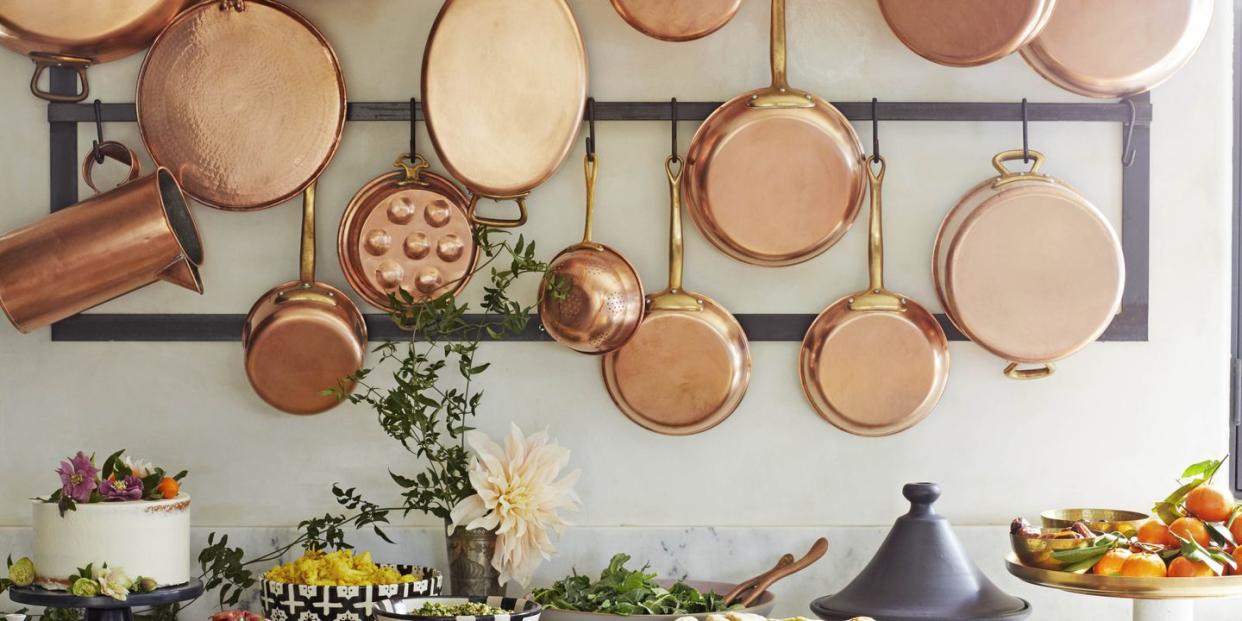How to Perfectly Clean Copper, According to Experts

"Hearst Magazines and Yahoo may earn commission or revenue on some items through these links."
Copper adds undeniable charm to a home; the lustrous metal creates a natural sense of warmth in a home that is almost impossible to replicate. Whether found on cookware hanging on a kitchen wall or bakeware lining the shelves of a butler's pantry, copper seamlessly blends into any design style, adding a subtle glow to every room. Though, it takes a lot of care to keep that copper shining for years.
Cleaning or polishing copper feels intimidating at first because it builds up grime more easily than other metals such as brass or silver. However, once you get into the habit of cleaning your copper properly, you'll realize just how easy it really is. "If you use the right amount of care and patience when cleaning your copper, it is sure to be long lasting and beautiful for a long time," says Dominique Giosa, art handler supervisor at M.S. Rau.
Bill Borman, founder of the vintage French cookware shop Piggy Kitchen, adds that people should not be afraid to use their beautiful copper cookware as long as they clean it properly and regularly. "Copper cookware doesn’t have to be babied, but there are a few guidelines," says Borman.
Below, Borman and Giosa reveal their copper-cleaning tips for removing tarnish once and for all. Here's how to clean and polish copper, according to these pros.
The Best Tools and Products to Clean Copper
It's pertinent to only use gentle cloths, sponges, and cleaning products when cleaning copper, as it is an extremely soft metal. Scouring pads and harsh chemicals can scratch the copper and ultimately make the cookware or decorative pieces lose their shine. As for cleaning solutions, Borman uses Bar Keepers Friend or Wright’s Copper Creme to revive all of his personal copper pieces as well as those sold at Piggy Kitchen. For a more natural cleaning solution that tackles tarnish, Giosa recommends mixing together 1/4 cup of salt and 1/4 cup of flour and then adding enough vinegar to create a paste.
Bar Keepers Friend Soft Cleanser
amazon.com
$7.50
amazon.comWright's Copper and Brass Cream Cleaner
amazon.com
$7.86
amazon.comHow to Clean Copper
Tarnish refers to the layer of corrosion that appears on metals when they are exposed to air and water over time. In the case of copper, it is often in the form of a not-so-appealing green or brown shade on your favorite piece of cookware. The best way to keep items from tarnishing is by cleaning and polishing your copper every six months.
Check to see if your piece has been lacquered before whipping out the microfiber cloths and cleaning products. First, see if you can notice a glossier finish on the piece rather than a subtle glow. If the piece also collects dust and grime rather than changing colors, it is likely the copper has a protective layer of lacquer on it. For lacquered copper, all you need to do is give the piece a gentle cleaning with mild dish soap and warm water and pat it dry with a cloth.
For unlacquered copperware showing tarnish, start by gently cleaning each piece with warm, soapy water and a soft sponge. This helps to remove the initial layer of grime while also helping you see how your piece will react to a cleaning. "Because the age of copper is often hard to identify, always take precaution and first use a water and soap combination when you first start cleaning," say Giosa.
Then, apply your cleaning solution liberally to the wet cookware and gently wash with a damp towel in buffing motions. Once the tarnish is removed, rinse and dry the piece with a soft, microfiber cloth. Your copperware will naturally develop a burnished patina with age—this is a good thing, as it means the copper is getting harder and actually will conduct heat better.
If you choose to polish your copper, Borman warns it will take some elbow grease to get it to a mirror-like finish. Borman says, "I polish hundreds of pieces of copper a year with a professional buffing wheel, and it’s an incredibly dirty job." Skip the polish and embrace the copper's naturally aged look!
You Might Also Like
